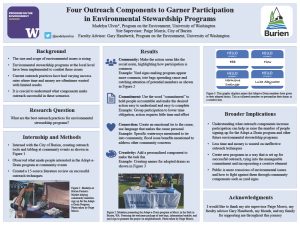Four Outreach Components to Garner Participation in Environmental Stewardship Programs
With an increase in both size and scale of environmental issues, communities are working to incorporate environmental programs to create a difference at the individual level. These environmental stewardship programs have had varying levels of participation, sometimes wasting valuable time and money with limited results. The aim of this study is to determine what outreach practices are helpful in gaining community participation. This research can be used in future program outreach to make positive environmental change. To accomplish this task, I used observations from promoting the Adopt-a-Drain program at community events as well as a literature review into what outreach techniques have positive results. The combination of personal experience and research into outreach practices helped to determine the best outreach practices for environmental stewardship programs such as the Adopt-a-Drian program. The results of my research and experience displayed how the four components of community, commitment, connection, and creativity are beneficial focuses in outreach practices. By including outreach components centered around shaping social norms, making tasks both easy and accessible, creating emotional ties, and making the task fun or personalized, people are more likely to participate, Understanding the psychology behind actions can help us create better outreach materials and create better program layouts to appeal to the communities that we want to reach. Garnering participation in environmental programs not only encourages more people to complete a simple task, but creates a more environmentally aware public.
